NURS3003: Critique of Evidence Based Nursing Research Article
VerifiedAdded on 2023/06/04
|7
|1705
|128
Report
AI Summary
This report presents a critical analysis of a qualitative research article that investigated community nurses' decision-making processes regarding anticipatory medication for end-of-life care. The critique examines various aspects of the study, including the title, literature review, sampling and recruitment methods, data collection techniques, data analysis approaches, and ethical considerations. The analysis highlights the strengths and weaknesses of each section, supported by relevant literature on research methodology. The study used a qualitative interpretive descriptive enquiry, employing semi-structured interviews with community palliative and district nurses. The findings were analyzed using Braun and Clarke's thematic analysis, revealing themes related to nurses' perceptions and practices concerning anticipatory medication. The report assesses the study's rigor, validity, and reliability, providing a comprehensive evaluation of its contribution to evidence-based nursing practice. The critique uses the provided assessment guidelines to ensure a structured and thorough analysis of the research article.
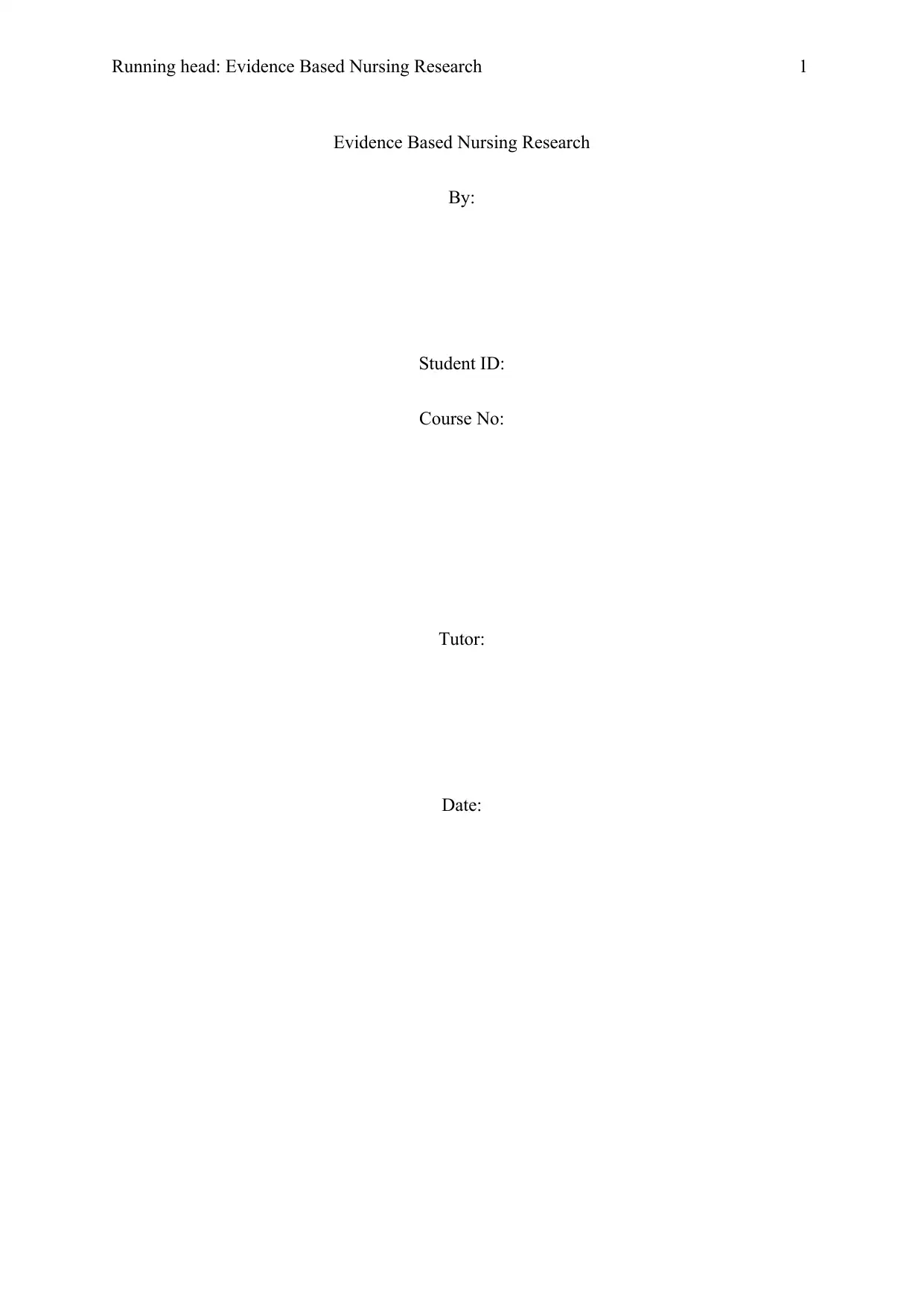
Running head: Evidence Based Nursing Research 1
Evidence Based Nursing Research
By:
Student ID:
Course No:
Tutor:
Date:
Evidence Based Nursing Research
By:
Student ID:
Course No:
Tutor:
Date:
Paraphrase This Document
Need a fresh take? Get an instant paraphrase of this document with our AI Paraphraser
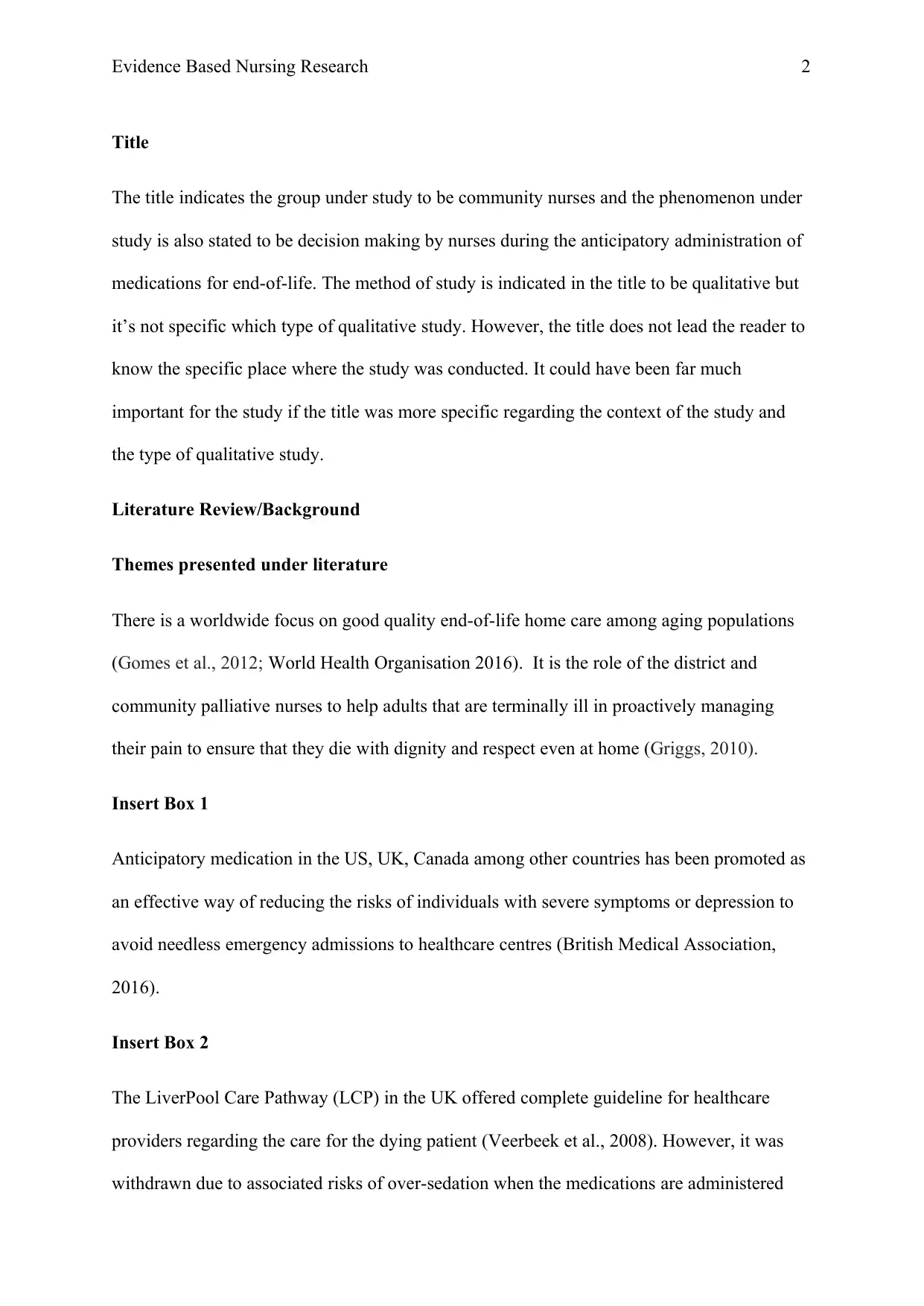
Evidence Based Nursing Research 2
Title
The title indicates the group under study to be community nurses and the phenomenon under
study is also stated to be decision making by nurses during the anticipatory administration of
medications for end-of-life. The method of study is indicated in the title to be qualitative but
it’s not specific which type of qualitative study. However, the title does not lead the reader to
know the specific place where the study was conducted. It could have been far much
important for the study if the title was more specific regarding the context of the study and
the type of qualitative study.
Literature Review/Background
Themes presented under literature
There is a worldwide focus on good quality end-of-life home care among aging populations
(Gomes et al., 2012; World Health Organisation 2016). It is the role of the district and
community palliative nurses to help adults that are terminally ill in proactively managing
their pain to ensure that they die with dignity and respect even at home (Griggs, 2010).
Insert Box 1
Anticipatory medication in the US, UK, Canada among other countries has been promoted as
an effective way of reducing the risks of individuals with severe symptoms or depression to
avoid needless emergency admissions to healthcare centres (British Medical Association,
2016).
Insert Box 2
The LiverPool Care Pathway (LCP) in the UK offered complete guideline for healthcare
providers regarding the care for the dying patient (Veerbeek et al., 2008). However, it was
withdrawn due to associated risks of over-sedation when the medications are administered
Title
The title indicates the group under study to be community nurses and the phenomenon under
study is also stated to be decision making by nurses during the anticipatory administration of
medications for end-of-life. The method of study is indicated in the title to be qualitative but
it’s not specific which type of qualitative study. However, the title does not lead the reader to
know the specific place where the study was conducted. It could have been far much
important for the study if the title was more specific regarding the context of the study and
the type of qualitative study.
Literature Review/Background
Themes presented under literature
There is a worldwide focus on good quality end-of-life home care among aging populations
(Gomes et al., 2012; World Health Organisation 2016). It is the role of the district and
community palliative nurses to help adults that are terminally ill in proactively managing
their pain to ensure that they die with dignity and respect even at home (Griggs, 2010).
Insert Box 1
Anticipatory medication in the US, UK, Canada among other countries has been promoted as
an effective way of reducing the risks of individuals with severe symptoms or depression to
avoid needless emergency admissions to healthcare centres (British Medical Association,
2016).
Insert Box 2
The LiverPool Care Pathway (LCP) in the UK offered complete guideline for healthcare
providers regarding the care for the dying patient (Veerbeek et al., 2008). However, it was
withdrawn due to associated risks of over-sedation when the medications are administered
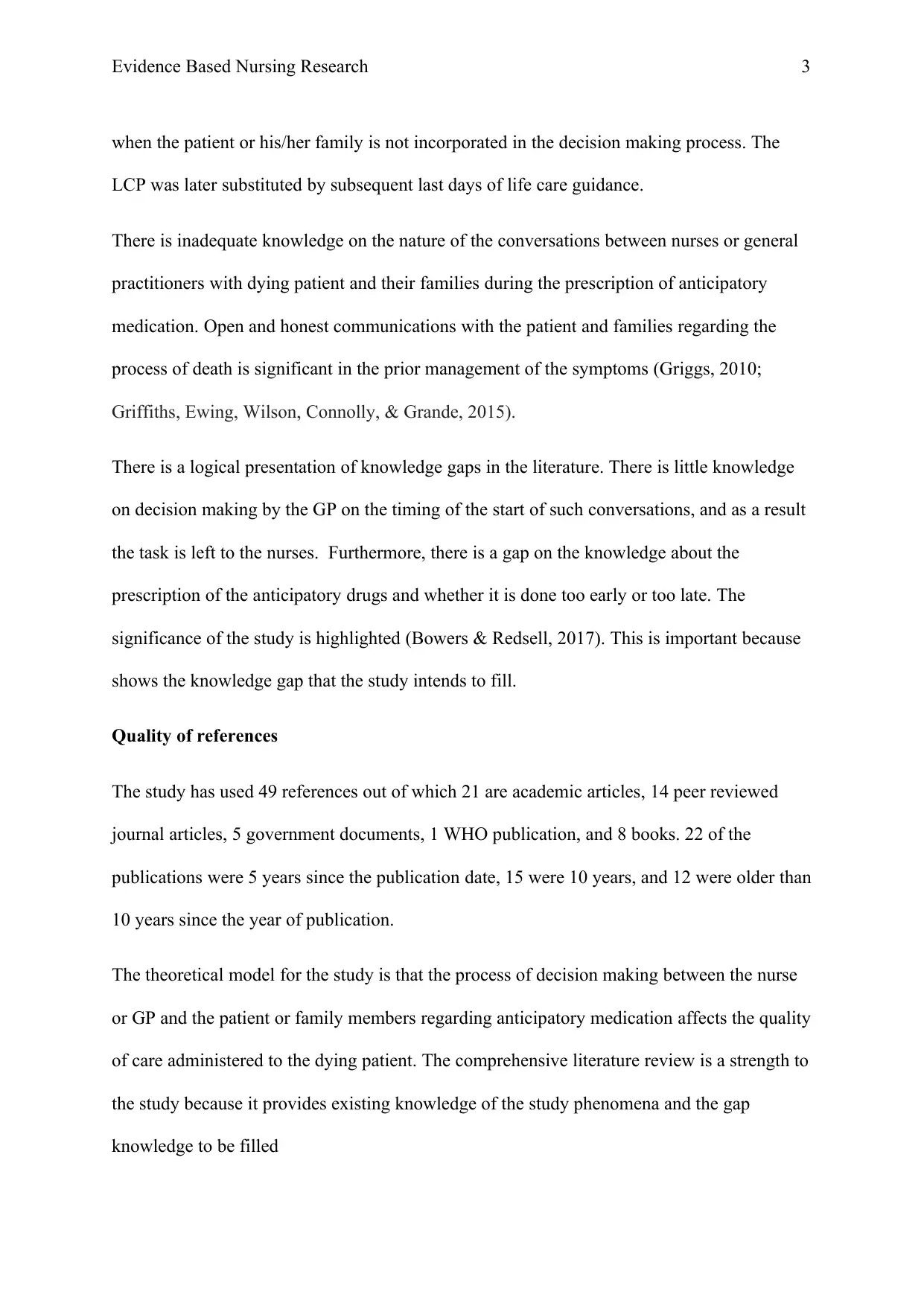
Evidence Based Nursing Research 3
when the patient or his/her family is not incorporated in the decision making process. The
LCP was later substituted by subsequent last days of life care guidance.
There is inadequate knowledge on the nature of the conversations between nurses or general
practitioners with dying patient and their families during the prescription of anticipatory
medication. Open and honest communications with the patient and families regarding the
process of death is significant in the prior management of the symptoms (Griggs, 2010;
Griffiths, Ewing, Wilson, Connolly, & Grande, 2015).
There is a logical presentation of knowledge gaps in the literature. There is little knowledge
on decision making by the GP on the timing of the start of such conversations, and as a result
the task is left to the nurses. Furthermore, there is a gap on the knowledge about the
prescription of the anticipatory drugs and whether it is done too early or too late. The
significance of the study is highlighted (Bowers & Redsell, 2017). This is important because
shows the knowledge gap that the study intends to fill.
Quality of references
The study has used 49 references out of which 21 are academic articles, 14 peer reviewed
journal articles, 5 government documents, 1 WHO publication, and 8 books. 22 of the
publications were 5 years since the publication date, 15 were 10 years, and 12 were older than
10 years since the year of publication.
The theoretical model for the study is that the process of decision making between the nurse
or GP and the patient or family members regarding anticipatory medication affects the quality
of care administered to the dying patient. The comprehensive literature review is a strength to
the study because it provides existing knowledge of the study phenomena and the gap
knowledge to be filled
when the patient or his/her family is not incorporated in the decision making process. The
LCP was later substituted by subsequent last days of life care guidance.
There is inadequate knowledge on the nature of the conversations between nurses or general
practitioners with dying patient and their families during the prescription of anticipatory
medication. Open and honest communications with the patient and families regarding the
process of death is significant in the prior management of the symptoms (Griggs, 2010;
Griffiths, Ewing, Wilson, Connolly, & Grande, 2015).
There is a logical presentation of knowledge gaps in the literature. There is little knowledge
on decision making by the GP on the timing of the start of such conversations, and as a result
the task is left to the nurses. Furthermore, there is a gap on the knowledge about the
prescription of the anticipatory drugs and whether it is done too early or too late. The
significance of the study is highlighted (Bowers & Redsell, 2017). This is important because
shows the knowledge gap that the study intends to fill.
Quality of references
The study has used 49 references out of which 21 are academic articles, 14 peer reviewed
journal articles, 5 government documents, 1 WHO publication, and 8 books. 22 of the
publications were 5 years since the publication date, 15 were 10 years, and 12 were older than
10 years since the year of publication.
The theoretical model for the study is that the process of decision making between the nurse
or GP and the patient or family members regarding anticipatory medication affects the quality
of care administered to the dying patient. The comprehensive literature review is a strength to
the study because it provides existing knowledge of the study phenomena and the gap
knowledge to be filled
⊘ This is a preview!⊘
Do you want full access?
Subscribe today to unlock all pages.

Trusted by 1+ million students worldwide
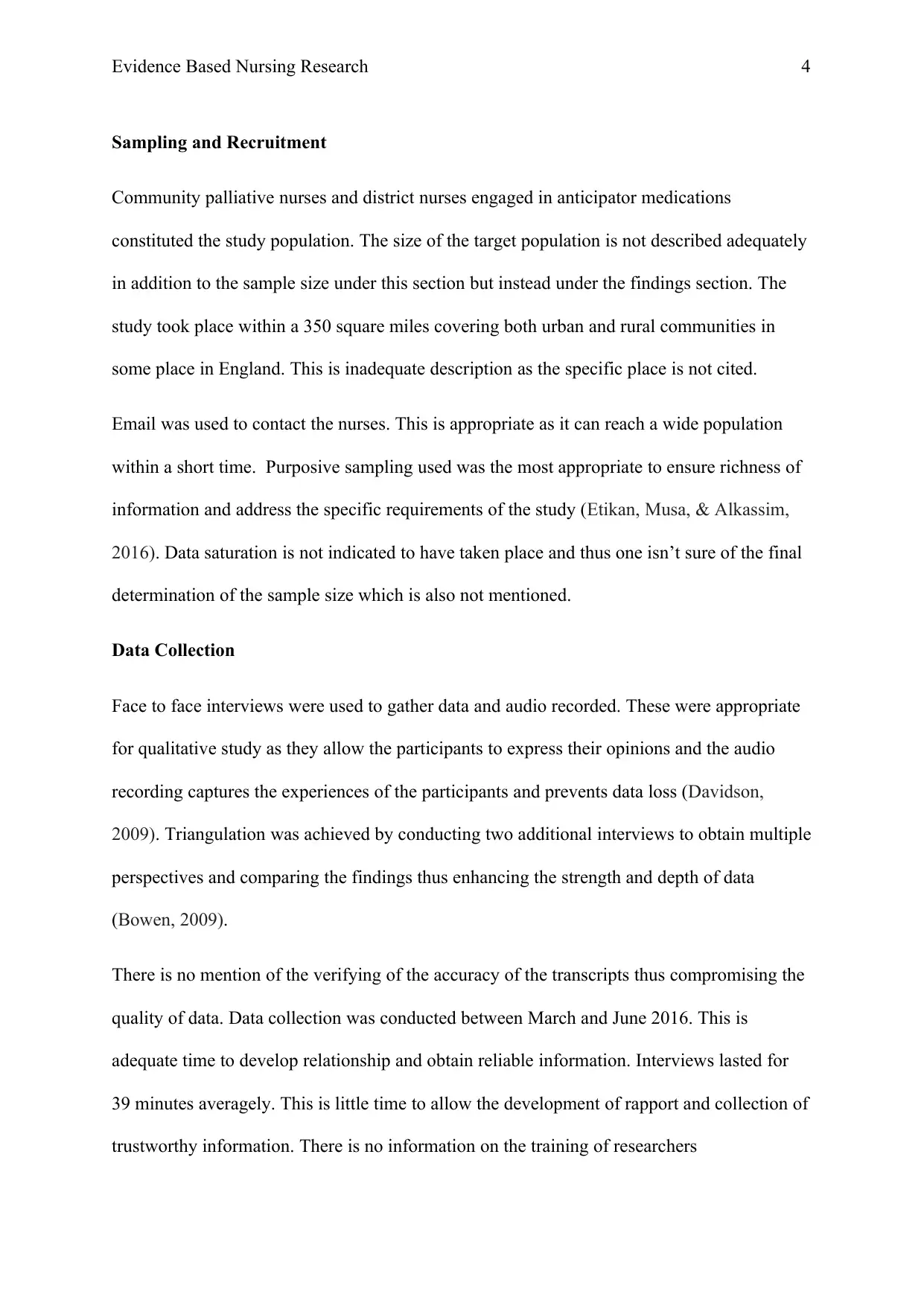
Evidence Based Nursing Research 4
Sampling and Recruitment
Community palliative nurses and district nurses engaged in anticipator medications
constituted the study population. The size of the target population is not described adequately
in addition to the sample size under this section but instead under the findings section. The
study took place within a 350 square miles covering both urban and rural communities in
some place in England. This is inadequate description as the specific place is not cited.
Email was used to contact the nurses. This is appropriate as it can reach a wide population
within a short time. Purposive sampling used was the most appropriate to ensure richness of
information and address the specific requirements of the study (Etikan, Musa, & Alkassim,
2016). Data saturation is not indicated to have taken place and thus one isn’t sure of the final
determination of the sample size which is also not mentioned.
Data Collection
Face to face interviews were used to gather data and audio recorded. These were appropriate
for qualitative study as they allow the participants to express their opinions and the audio
recording captures the experiences of the participants and prevents data loss (Davidson,
2009). Triangulation was achieved by conducting two additional interviews to obtain multiple
perspectives and comparing the findings thus enhancing the strength and depth of data
(Bowen, 2009).
There is no mention of the verifying of the accuracy of the transcripts thus compromising the
quality of data. Data collection was conducted between March and June 2016. This is
adequate time to develop relationship and obtain reliable information. Interviews lasted for
39 minutes averagely. This is little time to allow the development of rapport and collection of
trustworthy information. There is no information on the training of researchers
Sampling and Recruitment
Community palliative nurses and district nurses engaged in anticipator medications
constituted the study population. The size of the target population is not described adequately
in addition to the sample size under this section but instead under the findings section. The
study took place within a 350 square miles covering both urban and rural communities in
some place in England. This is inadequate description as the specific place is not cited.
Email was used to contact the nurses. This is appropriate as it can reach a wide population
within a short time. Purposive sampling used was the most appropriate to ensure richness of
information and address the specific requirements of the study (Etikan, Musa, & Alkassim,
2016). Data saturation is not indicated to have taken place and thus one isn’t sure of the final
determination of the sample size which is also not mentioned.
Data Collection
Face to face interviews were used to gather data and audio recorded. These were appropriate
for qualitative study as they allow the participants to express their opinions and the audio
recording captures the experiences of the participants and prevents data loss (Davidson,
2009). Triangulation was achieved by conducting two additional interviews to obtain multiple
perspectives and comparing the findings thus enhancing the strength and depth of data
(Bowen, 2009).
There is no mention of the verifying of the accuracy of the transcripts thus compromising the
quality of data. Data collection was conducted between March and June 2016. This is
adequate time to develop relationship and obtain reliable information. Interviews lasted for
39 minutes averagely. This is little time to allow the development of rapport and collection of
trustworthy information. There is no information on the training of researchers
Paraphrase This Document
Need a fresh take? Get an instant paraphrase of this document with our AI Paraphraser
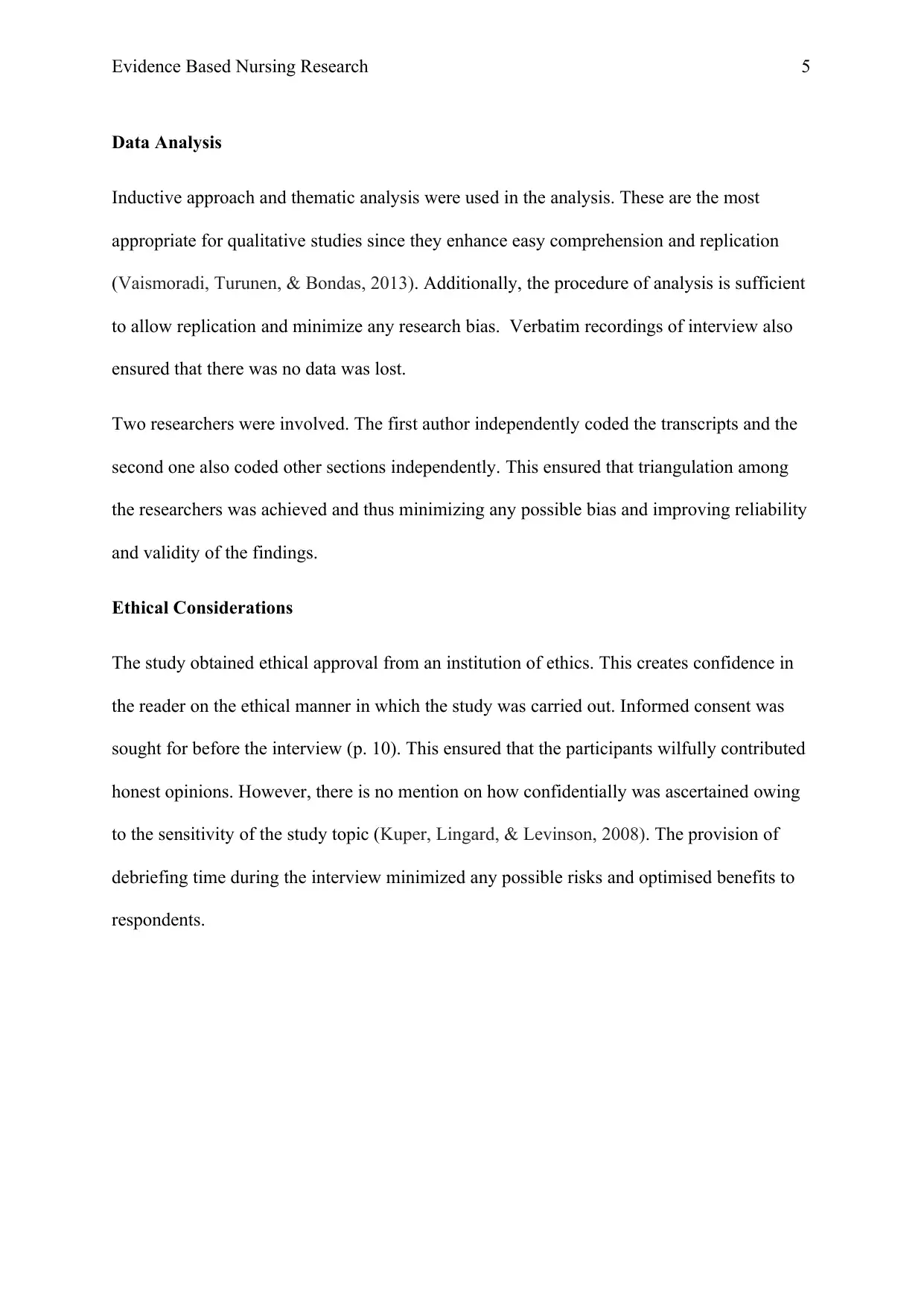
Evidence Based Nursing Research 5
Data Analysis
Inductive approach and thematic analysis were used in the analysis. These are the most
appropriate for qualitative studies since they enhance easy comprehension and replication
(Vaismoradi, Turunen, & Bondas, 2013). Additionally, the procedure of analysis is sufficient
to allow replication and minimize any research bias. Verbatim recordings of interview also
ensured that there was no data was lost.
Two researchers were involved. The first author independently coded the transcripts and the
second one also coded other sections independently. This ensured that triangulation among
the researchers was achieved and thus minimizing any possible bias and improving reliability
and validity of the findings.
Ethical Considerations
The study obtained ethical approval from an institution of ethics. This creates confidence in
the reader on the ethical manner in which the study was carried out. Informed consent was
sought for before the interview (p. 10). This ensured that the participants wilfully contributed
honest opinions. However, there is no mention on how confidentially was ascertained owing
to the sensitivity of the study topic (Kuper, Lingard, & Levinson, 2008). The provision of
debriefing time during the interview minimized any possible risks and optimised benefits to
respondents.
Data Analysis
Inductive approach and thematic analysis were used in the analysis. These are the most
appropriate for qualitative studies since they enhance easy comprehension and replication
(Vaismoradi, Turunen, & Bondas, 2013). Additionally, the procedure of analysis is sufficient
to allow replication and minimize any research bias. Verbatim recordings of interview also
ensured that there was no data was lost.
Two researchers were involved. The first author independently coded the transcripts and the
second one also coded other sections independently. This ensured that triangulation among
the researchers was achieved and thus minimizing any possible bias and improving reliability
and validity of the findings.
Ethical Considerations
The study obtained ethical approval from an institution of ethics. This creates confidence in
the reader on the ethical manner in which the study was carried out. Informed consent was
sought for before the interview (p. 10). This ensured that the participants wilfully contributed
honest opinions. However, there is no mention on how confidentially was ascertained owing
to the sensitivity of the study topic (Kuper, Lingard, & Levinson, 2008). The provision of
debriefing time during the interview minimized any possible risks and optimised benefits to
respondents.
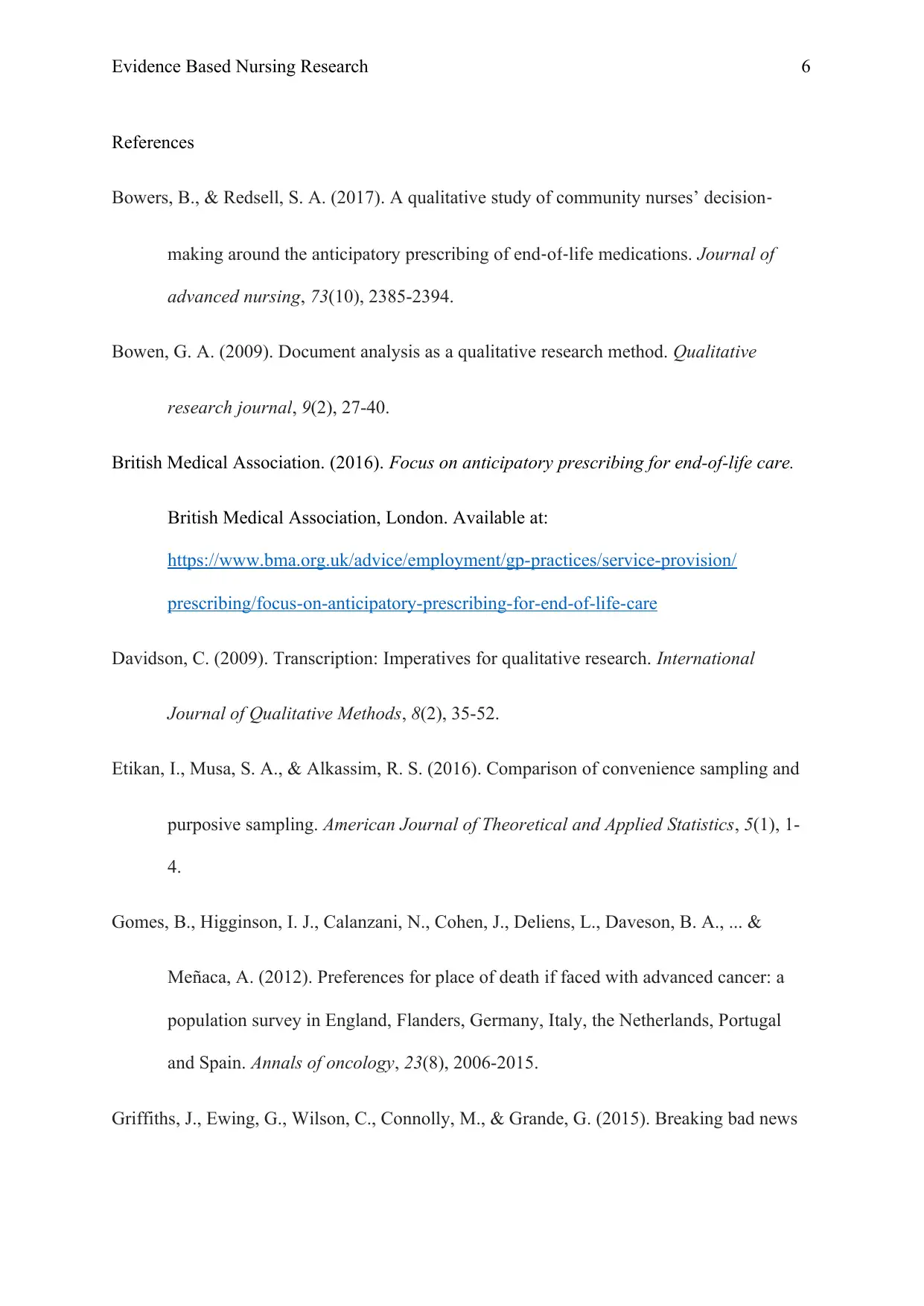
Evidence Based Nursing Research 6
References
Bowers, B., & Redsell, S. A. (2017). A qualitative study of community nurses’ decision‐
making around the anticipatory prescribing of end‐of‐life medications. Journal of
advanced nursing, 73(10), 2385-2394.
Bowen, G. A. (2009). Document analysis as a qualitative research method. Qualitative
research journal, 9(2), 27-40.
British Medical Association. (2016). Focus on anticipatory prescribing for end-of-life care.
British Medical Association, London. Available at:
https://www.bma.org.uk/advice/employment/gp-practices/service-provision/
prescribing/focus-on-anticipatory-prescribing-for-end-of-life-care
Davidson, C. (2009). Transcription: Imperatives for qualitative research. International
Journal of Qualitative Methods, 8(2), 35-52.
Etikan, I., Musa, S. A., & Alkassim, R. S. (2016). Comparison of convenience sampling and
purposive sampling. American Journal of Theoretical and Applied Statistics, 5(1), 1-
4.
Gomes, B., Higginson, I. J., Calanzani, N., Cohen, J., Deliens, L., Daveson, B. A., ... &
Meñaca, A. (2012). Preferences for place of death if faced with advanced cancer: a
population survey in England, Flanders, Germany, Italy, the Netherlands, Portugal
and Spain. Annals of oncology, 23(8), 2006-2015.
Griffiths, J., Ewing, G., Wilson, C., Connolly, M., & Grande, G. (2015). Breaking bad news
References
Bowers, B., & Redsell, S. A. (2017). A qualitative study of community nurses’ decision‐
making around the anticipatory prescribing of end‐of‐life medications. Journal of
advanced nursing, 73(10), 2385-2394.
Bowen, G. A. (2009). Document analysis as a qualitative research method. Qualitative
research journal, 9(2), 27-40.
British Medical Association. (2016). Focus on anticipatory prescribing for end-of-life care.
British Medical Association, London. Available at:
https://www.bma.org.uk/advice/employment/gp-practices/service-provision/
prescribing/focus-on-anticipatory-prescribing-for-end-of-life-care
Davidson, C. (2009). Transcription: Imperatives for qualitative research. International
Journal of Qualitative Methods, 8(2), 35-52.
Etikan, I., Musa, S. A., & Alkassim, R. S. (2016). Comparison of convenience sampling and
purposive sampling. American Journal of Theoretical and Applied Statistics, 5(1), 1-
4.
Gomes, B., Higginson, I. J., Calanzani, N., Cohen, J., Deliens, L., Daveson, B. A., ... &
Meñaca, A. (2012). Preferences for place of death if faced with advanced cancer: a
population survey in England, Flanders, Germany, Italy, the Netherlands, Portugal
and Spain. Annals of oncology, 23(8), 2006-2015.
Griffiths, J., Ewing, G., Wilson, C., Connolly, M., & Grande, G. (2015). Breaking bad news
⊘ This is a preview!⊘
Do you want full access?
Subscribe today to unlock all pages.

Trusted by 1+ million students worldwide
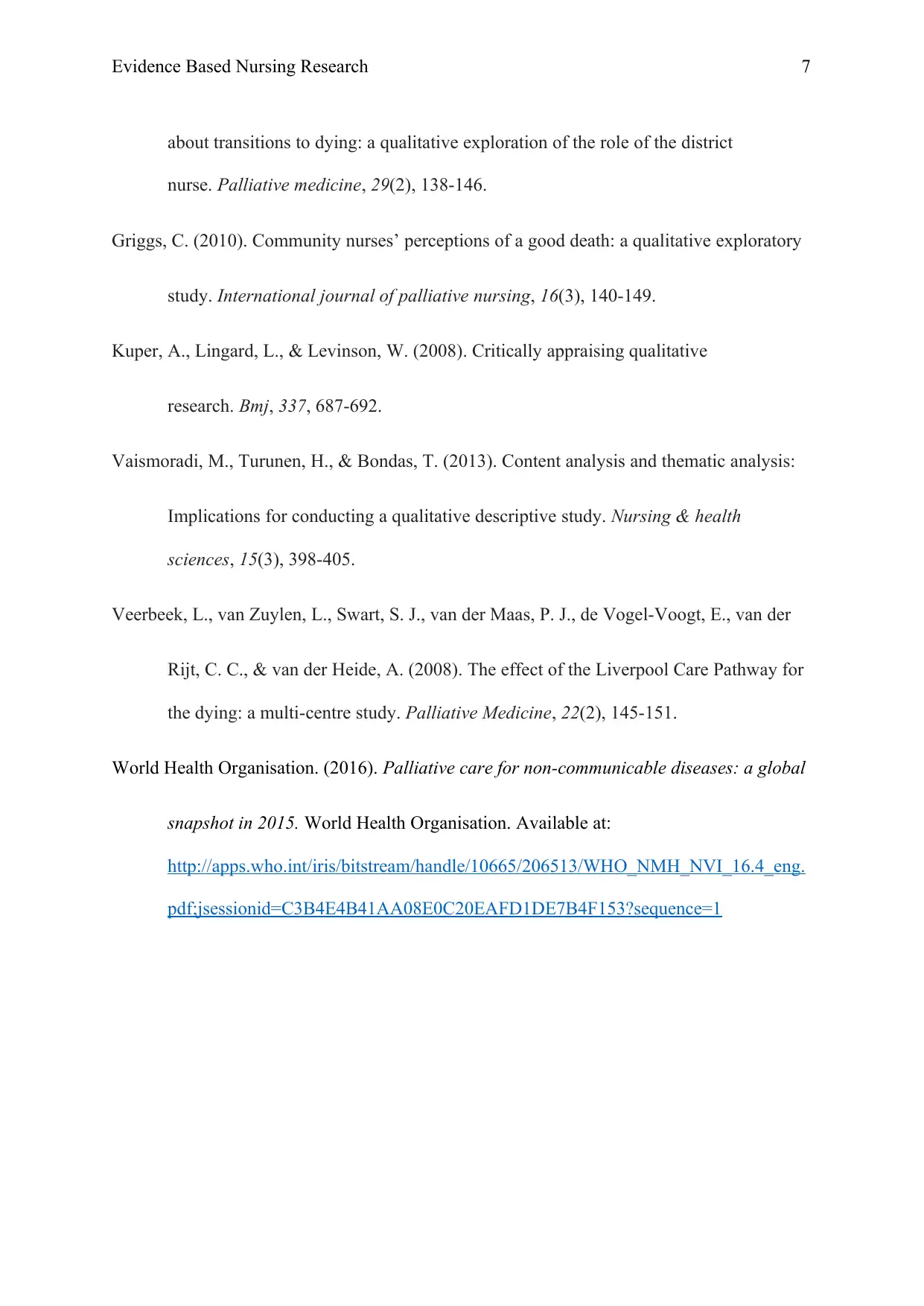
Evidence Based Nursing Research 7
about transitions to dying: a qualitative exploration of the role of the district
nurse. Palliative medicine, 29(2), 138-146.
Griggs, C. (2010). Community nurses’ perceptions of a good death: a qualitative exploratory
study. International journal of palliative nursing, 16(3), 140-149.
Kuper, A., Lingard, L., & Levinson, W. (2008). Critically appraising qualitative
research. Bmj, 337, 687-692.
Vaismoradi, M., Turunen, H., & Bondas, T. (2013). Content analysis and thematic analysis:
Implications for conducting a qualitative descriptive study. Nursing & health
sciences, 15(3), 398-405.
Veerbeek, L., van Zuylen, L., Swart, S. J., van der Maas, P. J., de Vogel-Voogt, E., van der
Rijt, C. C., & van der Heide, A. (2008). The effect of the Liverpool Care Pathway for
the dying: a multi-centre study. Palliative Medicine, 22(2), 145-151.
World Health Organisation. (2016). Palliative care for non-communicable diseases: a global
snapshot in 2015. World Health Organisation. Available at:
http://apps.who.int/iris/bitstream/handle/10665/206513/WHO_NMH_NVI_16.4_eng.
pdf;jsessionid=C3B4E4B41AA08E0C20EAFD1DE7B4F153?sequence=1
about transitions to dying: a qualitative exploration of the role of the district
nurse. Palliative medicine, 29(2), 138-146.
Griggs, C. (2010). Community nurses’ perceptions of a good death: a qualitative exploratory
study. International journal of palliative nursing, 16(3), 140-149.
Kuper, A., Lingard, L., & Levinson, W. (2008). Critically appraising qualitative
research. Bmj, 337, 687-692.
Vaismoradi, M., Turunen, H., & Bondas, T. (2013). Content analysis and thematic analysis:
Implications for conducting a qualitative descriptive study. Nursing & health
sciences, 15(3), 398-405.
Veerbeek, L., van Zuylen, L., Swart, S. J., van der Maas, P. J., de Vogel-Voogt, E., van der
Rijt, C. C., & van der Heide, A. (2008). The effect of the Liverpool Care Pathway for
the dying: a multi-centre study. Palliative Medicine, 22(2), 145-151.
World Health Organisation. (2016). Palliative care for non-communicable diseases: a global
snapshot in 2015. World Health Organisation. Available at:
http://apps.who.int/iris/bitstream/handle/10665/206513/WHO_NMH_NVI_16.4_eng.
pdf;jsessionid=C3B4E4B41AA08E0C20EAFD1DE7B4F153?sequence=1
1 out of 7
Related Documents
Your All-in-One AI-Powered Toolkit for Academic Success.
+13062052269
info@desklib.com
Available 24*7 on WhatsApp / Email
![[object Object]](/_next/static/media/star-bottom.7253800d.svg)
Unlock your academic potential
Copyright © 2020–2025 A2Z Services. All Rights Reserved. Developed and managed by ZUCOL.





